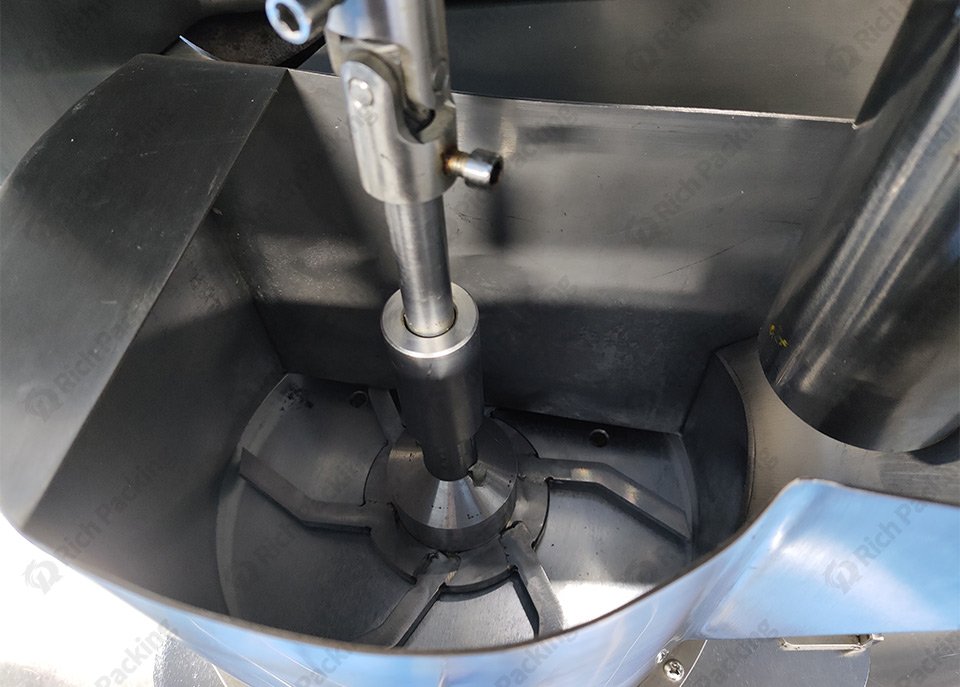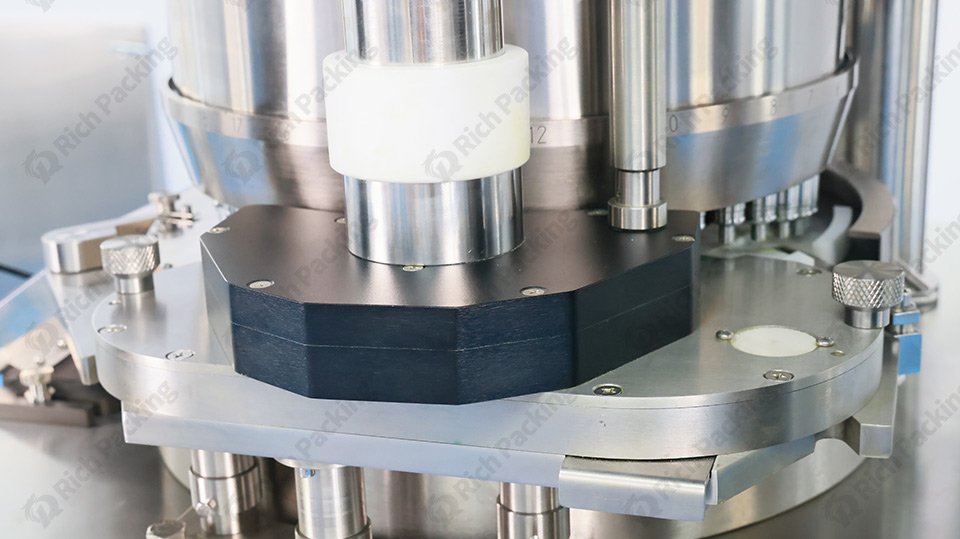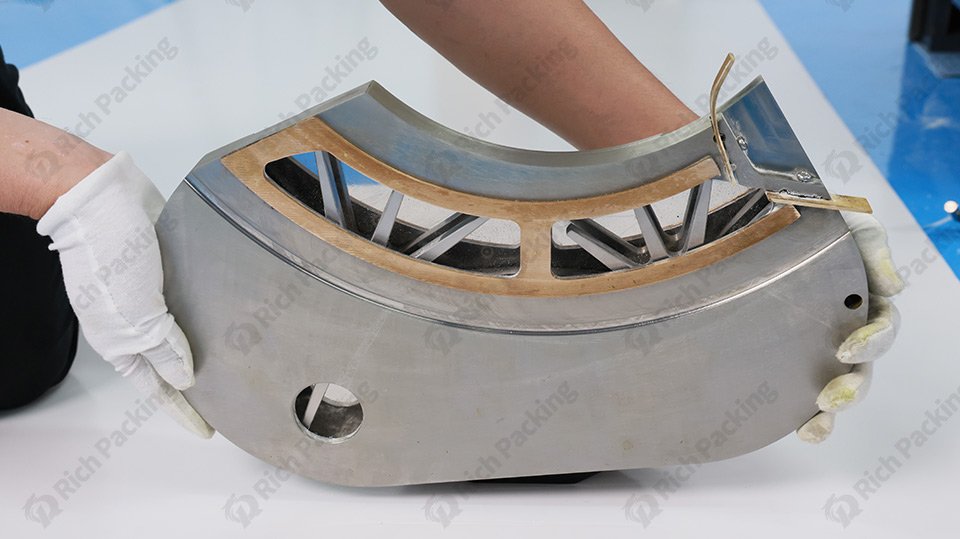Tablet presses machine are indispensable equipment in the pharmaceutical, food, and chemical industries, primarily used to compress powder or granular materials into tablets. The feeding method plays a crucial role in the operation of the tablet press, directly affecting the quality and efficiency of tablet production. This article provides a detailed introduction to various feeding methods of tablet presses and their applications, helping readers better understand and choose the appropriate feeding method.
The feeding method refers to the way materials are transported from the hopper into the tablet mold. Depending on the characteristics of the materials and production requirements, different feeding methods are used in tablet presses. The common feeding methods are mainly classified into gravity feeding and forced feeding.
Gravity feeding is one of the most common feeding methods. Its basic principle is to use gravity to direct materials from the hopper directly into the tablet mold. This method is suitable for powders and granular materials with good flow properties.

Simple Structure: Gravity feeding equipment has a relatively simple structure, making it easy to maintain.
Low Cost: Due to the simplicity of the equipment, production and maintenance costs are low, making it suitable for small to medium-scale production.
Ease of Operation: The operation process is simple and does not require complex control systems.
High Flowability Requirement: Gravity feeding requires materials with good flow properties and is not suitable for materials with poor flowability.
Susceptibility to Environmental Factors: The feeding process is easily affected by environmental factors (such as humidity and temperature), which may lead to uneven feeding.
Gravity feeding is suitable for materials with good flow properties, such as certain pharmaceutical powders and granular foods. In these applications, gravity feeding ensures that materials enter the mold evenly, thereby ensuring the quality of the tablets.
Forced feeding uses mechanical devices (such as screws, rotors, etc.) to force materials into the tablet mold. This method is suitable for materials with poor flow properties and ensures uniform feeding, improving production efficiency and product quality.

Screw Feeding
Screw feeding uses a rotating screw to push materials into the mold. It is suitable for high-viscosity or poorly flowing materials. The rotation speed and angle of the screw can be adjusted to meet different material feeding requirements.
Rotor Feeding
Rotor feeding uses a rotating rotor to evenly distribute materials into the mold. It is suitable for larger granular materials. The design of the rotor ensures that materials do not clump during the feeding process, maintaining uniformity.
Vibration Feeding
Vibration feeding uses a vibrating device to ensure uniform feeding of materials. It is suitable for materials that tend to clump. The frequency and amplitude of the vibration can be adjusted to ensure uniformity during the feeding process.

Wide Applicability: Forced feeding is suitable for various materials with poor flow properties and is almost unaffected by material characteristics.
Uniform Feeding: The mechanical force ensures uniform feeding, making it suitable for high-precision production.
High Production Efficiency: Forced feeding can significantly improve production efficiency and reduce material waste during the feeding process.
Complex Structure: Forced feeding equipment has a relatively complex structure, resulting in higher maintenance costs.
High Energy Consumption: Due to the need for mechanical drive, forced feeding consumes more energy.
Operational Difficulty: Operation and maintenance require a certain level of technical expertise.
Forced feeding is widely used for various materials with poor flow properties, such as certain high-viscosity pharmaceutical powders, granules, and food additives. In these applications, forced feeding ensures uniform feeding, improving product quality and production efficiency.
1. Suitable Materials
Gravity Feeding: Suitable for materials with good flow properties, such as powders and granules.
Forced Feeding: Suitable for materials with poor flow properties, such as high-viscosity powders and granules.
Gravity Feeding: Equipment has a simple structure and is easy to maintain.
Forced Feeding: Equipment has a complex structure, resulting in higher maintenance costs.
Gravity Feeding: Lower production and maintenance costs, suitable for small to medium-scale production.
Forced Feeding: Higher production and maintenance costs, suitable for large-scale production.
Gravity Feeding: Feeding uniformity is relatively poor and easily affected by environmental factors.
Forced Feeding: Feeding uniformity is better, making it suitable for high-precision production.
Different materials have varying flow properties, viscosities, and particle sizes. When choosing a feeding method, it is essential to consider the material characteristics comprehensively. Materials with good flow properties can use gravity feeding, while materials with poor flow properties are more suitable for forced feeding.
Production scale and cost are also crucial factors in choosing a feeding method. For small to medium-scale production, the simple structure and low cost of gravity feeding equipment are more suitable. For large-scale production, the high efficiency and precision of forced feeding equipment are more advantageous.
In production processes with high product quality requirements, feeding uniformity and precision are critical. Due to its better uniformity and precision, forced feeding is more suitable for high-quality production.
1. Intelligent Control
With the advancement of technology, the application of intelligent control in feeding methods is becoming more widespread. Through sensors and automated control systems, real-time monitoring and adjustment of the feeding process can be achieved, improving feeding precision and efficiency.
Environmental protection and energy saving are important directions for the future development of feeding methods. Developing low-energy, high-efficiency feeding equipment can reduce production costs and minimize environmental impact.
Future feeding equipment will focus more on multi-function integration, incorporating various feeding methods into one device, enhancing the equipment's applicability and flexibility. This allows for the flexible selection and adjustment of feeding methods based on different production needs, improving production efficiency and product quality.